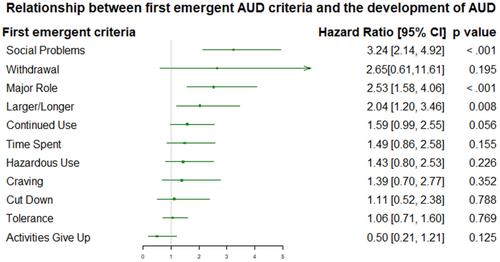The key role of specific DSM-5 diagnostic criteria in the early development of alcohol use disorder: Findings from the RADAR prospective cohort study
Abstract
Background
Prevention and early intervention of alcohol use disorder (AUD) is a public health priority, yet there are gaps in our understanding of how AUD emerges, which symptoms of AUD come first, and whether there are modifiable risk factors that forecast the development of the disorder. This study investigated potential early-warning-sign symptoms for the development of AUD.
Methods
Data were from the RADAR study, a prospective cohort study of contemporary emerging adults across Australia (n = 565, mean age = 18.9, range = 18–21 at baseline, 48% female). Participants were interviewed five times across a 2.5-year period. Diagnostic and Statistical Manual of Mental Disorders, Fifth Edition (DSM-5) AUD criteria and diagnoses were assessed by clinical psychologists using the Structured Clinical Interview for DSM-IV (SCID-IV), modified to cover DSM-5 criteria. Hazard analyses modeled the time from first alcoholic drink to the emergence of any AUD criteria and determined which first-emergent AUD criteria were associated with a faster transition to disorder.
Results
By the final time point, 54.8% of the sample had experienced at least one DSM-5 AUD criterion and 26.1% met criteria for DSM-5 AUD. The median time from first AUD criterion to a diagnosis of AUD was 4 years. Social problems from drinking (hazard ratio [HR] = 3.24, CI95 = 2.14, 4.92, p < 0.001), major role (HR = 2.53, CI95 = 1.58, 4.06, p < 0.001), and drinking larger amounts/for longer than intended (HR = 2.04, CI95 = 1.20, 3.46, p = 0.008) were first-onset criteria associated with a faster transition to AUD.
Conclusion
In the context of a prospective general population cohort study of the temporal development of AUD, alcohol-related social problems, major role problems, and using more or for longer than intended are key risk factors that may be targeted for early intervention.



 求助内容:
求助内容: 应助结果提醒方式:
应助结果提醒方式:


